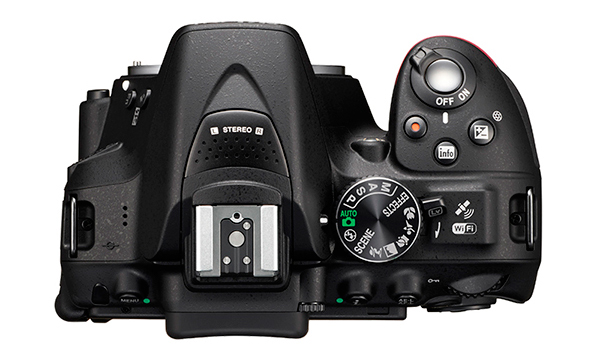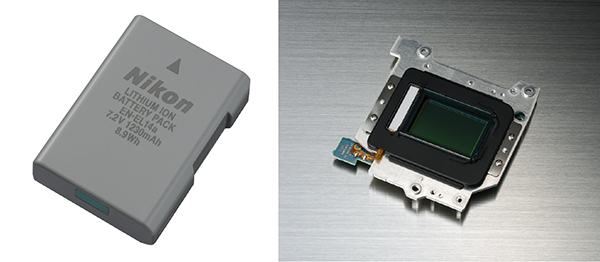<
Nikon D5300 Discountp>/PRNewswire/ --
The new Nikon D5300 with built-in Wi-Fi® and GPS makes it simple to share high quality images
Nikon Singapore Pte Ltd is pleased to announce the release of the D5300, Nikon's latest entry-level DX-format digital SLR camera.
(Photo: http://photos.prnewswire.com/prnh/20131110/652912 )
The D5300 offers an effective pixel count of 24.2-million pixels and is equipped with a Nikon DX-format CMOS sensor with no optical low-pass filter, as well as the new high-performance EXPEED 4 image-processing engine. It is Nikon's first digital SLR camera to offer built-in wireless LAN (Wi-Fi®) and GPS functions, so users can easily share high-quality images captured with the D5300 and NIKKOR lenses via a smart device. These functions also allow users to look back on routes taken on vacation or with outdoor activities using a log feature that is part of the built-in GPS function.
The D5300 is designed with a structure made of a new material to bring about a smaller and lighter body while maintaining the necessary strength and durability. The camera is also equipped with a number of features that support various shooting situations, including a 3.2-inch, approximately 1037k-dot vari-angle monitor with a wide viewing angle for shooting from a variety of angles, a full-HD movie recording function that supports recording of smooth 1920 × 1080/60p movies, and a Special Effects mode with nine options that can be applied to photos and movies with shooting for a variety of creative effects.
The Zoom/Focus Assist Lever NAL-1 for exclusive use with NIKKOR lenses will also be released at the same time as the D5300. The NAL-1 is a lever that enables smoother zooming and focusing when attached to the zoom ring or focus ring on a NIKKOR lens and is especially convenient for movie recording.
D5300 Primary Features
1. An effective pixel count of 24.2-million pixels anda Nikon DX-format CMOS sensor with no optical low-pass filter, and the latest image-processing engine, EXPEED 4, for superior image quality and definition
The D5300 offers an effective pixel count of 24.2-million pixels and is equipped with a DX-format CMOS image sensor developed exclusively by Nikon. It supports a broad range of standard sensitivities from ISO 100 to 12800, as well as an additional expansion of up to ISO 25600 equivalent (Hi 1) for high-definition images exhibiting very little noise with shooting at a broad range of sensitivities. In addition, the high-speed performance of the latest image-processing engine, EXPEED 4, optimized for high-performance digital SLR cameras, provides superior results with noise reduction (NR), auto white balance, color reproduction characteristics, tone processing, and image quality at high sensitivities. The absence of a low-pass filter maximizes the superior resolution of the high pixel count and rendering capabilities of NIKKOR lenses.
2. Built-in Wi-Fi for transferring high-quality images to a smart device for ease of sharing
As Nikon's first digital SLR camera equipped with a built-in Wi-Fi function, high-quality images with an effective pixel count of 24.2-million pixels captured from a variety of angles using the flexible vari-angle monitor can be transferred to a smart device for sharing with others[*1]. This expands the ways in which images are enjoyed after they are taken by enabling immediate image transfer for sharing photos with family and friends via blogs or social networking sites anytime, anywhere.
Transfer function: Images captured by the D5300, or already saved to a memory card inserted in the D5300, can be transferred to a smart device over a wireless connection. These images can then be viewed in the smart device display, or uploaded to a blog or social networking site. In addition, the size at which images are transferred to a smart device can be selected from two options to fit the storage capacity of the smart device.
Remote shooting function: The camera's live view shooting display can be shown on the display of the smart device in real time, allowing users to accurately frame photos and predict results with remote control while shooting[*2].
Manual upload function: Users can select images to be uploaded to a smart device using the D5300 monitor display. In situations or environments that do not sufficiently support immediate image upload, or when a smart device is not readily available, the camera can be used to specify images, and image file size, to be uploaded to the smart device at a later time.
[*1] The Wireless Mobile Utility app must first be installed on the smart device (the app can be downloaded free of charge from the smart device's app store).
[*2] Effective only when AF-area mode is set to "Normal-area AF" or "Wide-area AF".
3. A built-in GPS function that records location data and tracks movement
The D5300 is Nikon's first digital SLR camera with a built-in GPS function, enabling recording of location data (longitude, latitude, altitude) with images. It also works seamlessly with ViewNX 2, NIKON IMAGE SPACE, and commercial mapping software enables display of images where they were captured on maps, as well as sharing of images with location data. The A-GPS function also makes detection of location data smoother. This capability allows users to look back on memories or track their movement, on vacations or with outdoor activities by shooting location, and date and time of capture.
4. Designed using a new material for a smaller and lighter body that is strong and durable
The D5300 is designed using a new material. As the camera cover and body are formed with a rigid, integrated structure, there are fewer joints. This enables a smaller and lighter camera with a width of 125 mm, height of 98 mm, and depth of 76 mm, and weighing just 530 g[*], all while maintaining the necessary strength and durability.
* Including battery and SD memory card; excluding body cap.
5. A 3.2-inch, 1037k-dot vari-angle LCD monitor with wide viewing angle for simple shooting from any angle The D5300 features a larger 3.2-inch (approximately 1037k-dot) LCD monitor with wide viewing angle for a crisp and clear display. The side-hinged vari-angle monitor opens from 0 to 180° at the side, and can be rotated up to 90° clockwise and up to 180° counter-clockwise. This enables shooting from a wide variety of angles, from low to high, making even self-portraits possible.
6. D-Movie function for recording full-HD 1920 × 1080 60p movies
The D5300 is equipped with a D-Movie function that supports recording of 1920 × 1080/60p movies. The combination of NIKKOR lenses, a high pixel-count CMOS image sensor unit which does not include an optical low-pass filter, and an effective pixel count of 24.2-million pixels, enables recording of high-definition movies exhibiting superior rendering characteristics. In addition, autofocusing during movie recording is possible using contrast-detect AF. When the focus mode is set to full-time-servo AF (AF-F) and AF-area mode is set to Subject-tracking AF, the camera automatically maintains focus on moving subjects. Manual movie settings are also available, allowing users to choose the desired shutter speed and ISO sensitivity in live view mode and with movie recording. Movie frame rate with full-HD recording can be selected from 24p, 25p, 30p, 50p, and 60p. In addition to recording of high-quality sound via the built-in stereo microphone, the optional Stereo Microphone ME-1 can also be used to record stereo sound.
Toy Camera Effect: Create photos and movies in which colors have been changed and edges have been shaded so that they appear to have been recorded with a toy camera. Users can adjust the vividness and degree of vignetting (peripheral shading) from three options each to suit their individual preferences.
HDR Painting[*]: The camera shoots two frames at different exposures and combines them, with processing that changes color tones, for HDR images with a painterly effect.
7. Toy Camera Effect and HDR Painting added to Special Effects mode (total of 9 effects) for more creative expression with still images and movies
The D5300 is equipped with a Special Effects mode, with which effects can be selected and applied with recording of both still images and movies. The effects can also be previewed in the camera monitor in real time before shooting or recording begins. A total of nine special effects are available, including the seven built into the D5200 (Selective Color, Color Sketch, Miniature Effect, Night Vision, Silhouette, High Key, Low Key), as well as the new Toy Camera Effect and HDR Painting*. This allows users to easily utilize dramatic effects like those seen in art and the movies. This mode was incorporated into the D5300 to respond to the creative intent of users who were searching for a way to express their own unique style and creativity.
* HDR Painting cannot be applied to movies. Further, results of the HDR Painting effect cannot be previewed in the camera monitor.
8. Designed with a firm grip using just one hand and available in 3 colors, including a new gray option
The grip on the D5300 is designed to fit comfortably in the palm of the hand for a firm hold using just one hand, making framing via both the optical viewfinder and the monitor's live view display easier. In addition to the popular black and red colors, the D5300 is also available in a new gray option. Metal parts on the D5300, such as the microphone cover and plate over the mode dial, have also been designed with a surface finish that gives the camera an elegant appearance.
About Nikon Pricing and Availability
The Nikon 5300 will be available in three colors (Black, Red and Gray), starting in November 2013 at the suggested retail price (SRP) of AED 3,999. For more information on the new Nikon D5300 and other Nikon products, please visit http://www.nikon-mea.com.
Nikon, At the Heart of the Image. Nikon is the world leader in digital imaging, precision optics and photo imaging technology and is globally recognised for setting new standards in product design and performance for its award-winning consumer and professional photographic equipment. Nikon Singapore Pte Ltd distributes consumer and professional digital SLR cameras, NKKOR optics, Speedlights and system accessories; Nikon COOLPIX compact digital cameras; Nikon sports optics as well as the Nikon 1 advanced cameras with interchangeable lens system in over 50 countries.
For more information, visit http://www.nikon-mea.com. Connect with Nikon and other photographers on Facebook at http://www.facebook.com/NikonMEA and get the latest news and information from Twitter by following @NikonMEA.
SOURCE Nikon Corporation
* Read more articles by Nikon Corporation
Source:
Sacbee
 Little competition for cameras in its price range
Little competition for cameras in its price range 
 Image: The top of the camera houses only a few control points, keeping the layout simple and unintimidating for newcomers. A stereo microphone lives in front of the hotshoe
Image: The top of the camera houses only a few control points, keeping the layout simple and unintimidating for newcomers. A stereo microphone lives in front of the hotshoe  Image: The body styling will be familiar to those used to the Nikon 5000 series, as will the standard menu. The 3.2in flip-out screen has impressive visibility
Image: The body styling will be familiar to those used to the Nikon 5000 series, as will the standard menu. The 3.2in flip-out screen has impressive visibility  Image: Nikon has retained its choice of layouts for the rear-screen display, with text-based and graphically expressed options to suit personal preferences
Image: Nikon has retained its choice of layouts for the rear-screen display, with text-based and graphically expressed options to suit personal preferences  Image: The new battery, which is backwards compatible with the D5200, offers a longer life. There is no low-pass filter on the sensor, for extra resolution
Image: The new battery, which is backwards compatible with the D5200, offers a longer life. There is no low-pass filter on the sensor, for extra resolution